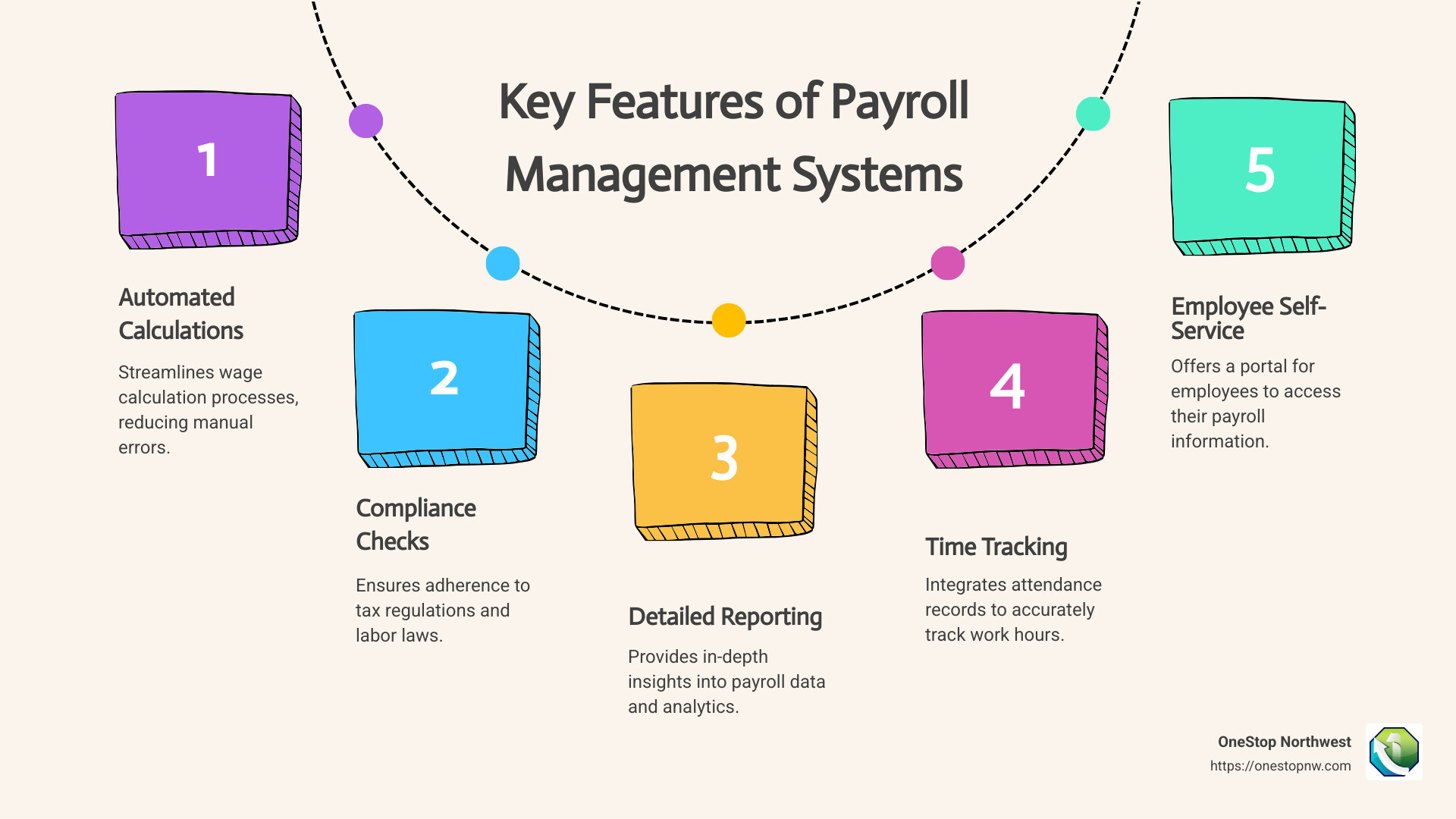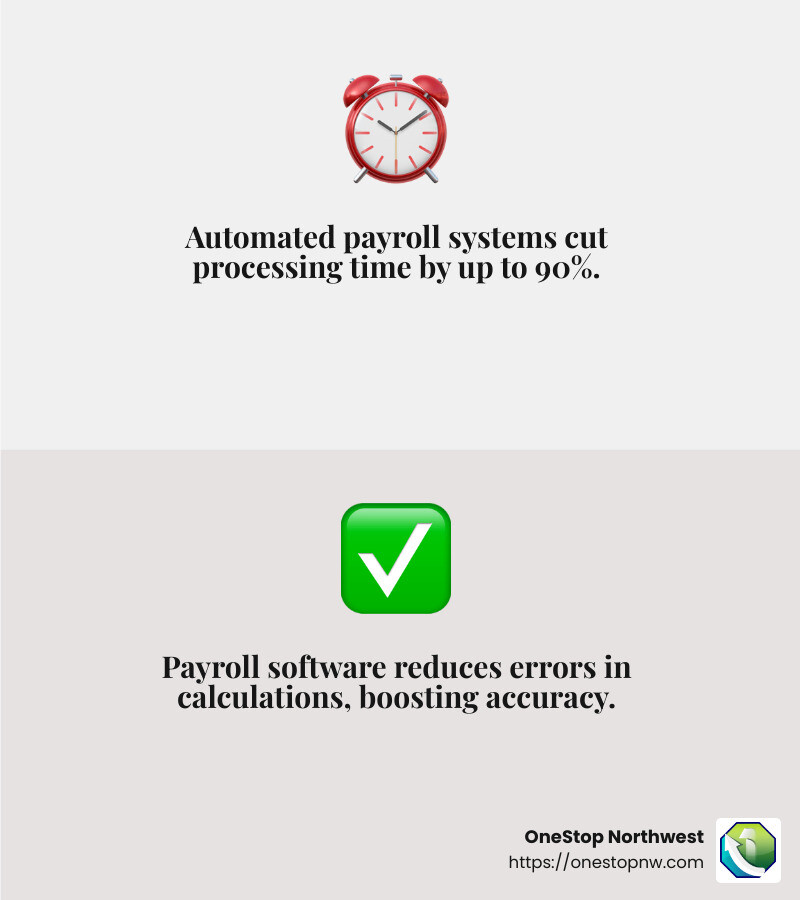Payroll Management System: Top 3 Essential Benefits 2025
A payroll management system is essential for any business that wants to handle employee compensation efficiently. These systems simplify your payroll process, making it easy to manage everything from calculating wages to ensuring tax compliance.
A payroll management system is important because it:
- Automates wage calculations and tax filings.
- Ensures accurate and timely employee payments.
- Reduces payroll errors and boosts compliance.
For small businesses, using a payroll management system can significantly cut down on time spent on manual data entry and reduce costly mistakes. By adopting a streamlined system, businesses can focus more on growth and employee satisfaction, knowing their payroll is managed accurately.
As Dylan Cleppe, with over two decades of experience managing business operations and customer service, I’ve seen how an effective payroll management system can revolutionize a company’s efficiency. Up next, let’s explore what a payroll management system truly entails and how it can benefit your business.

Key terms for payroll management system:
– automated payroll processing system
– manual payroll vs automated payroll
– payroll automation process
What is a Payroll Management System?
A payroll management system is a software solution that automates the entire payroll process. It handles everything from calculating employee wages to managing tax withholdings and generating paychecks. This system is crucial for businesses of all sizes, as it ensures that employees are paid accurately and on time.
Process Automation
One of the key advantages of a payroll management system is its ability to automate complex tasks. Traditionally, payroll involved manual calculations, which were time-consuming and prone to errors. With automation, tasks like calculating salaries, overtime, and deductions are completed in minutes. This not only saves time but also reduces the risk of costly mistakes.
For instance, HR Program Manager Josh Franklin shared that switching to an all-in-one HR system reduced payroll processing time by 90%. “Payroll now takes 20 minutes compared to four days,” he explained. This massive time saving allows businesses to focus on strategic initiatives rather than administrative tasks.
Ensuring Accurate Employee Payments
Accurate employee payments are essential for maintaining trust and satisfaction among your team. A payroll management system ensures that employees receive the correct amount, taking into account all variables such as bonuses, commissions, and deductions. This accuracy helps prevent overpayments or underpayments, which can lead to employee dissatisfaction and trust issues.
Automated systems like BambooHR minimize these risks by handling complex calculations efficiently. According to a recent survey, payroll software significantly reduces errors, ensuring accuracy in deductions, overtime pay, and PTO calculations.
Simplifying Tax Compliance
Tax compliance is a critical aspect of payroll management. A payroll management system automatically calculates and withholds the correct amounts for federal, state, and local taxes. It also handles tax filings and updates to tax codes, ensuring compliance with ever-changing regulations. This feature helps businesses avoid penalties and stay on top of their tax obligations.
In addition to tax management, automated payroll systems streamline other processes such as expense management and garnishment administration. This comprehensive approach not only saves time but also improves overall business operations.
By integrating a payroll management system into your business, you can ensure efficient, accurate, and compliant payroll processes. Next, let’s explore the different types of payroll management systems available to suit various business needs.
Types of Payroll Management Systems
When it comes to managing payroll, businesses have several options to choose from. Each method has its own advantages and challenges. Let’s explore the three main types: Manual Payroll Management, Payroll Management Software, and Comprehensive Outsourcing.
Manual Payroll Management
Manual management involves handling payroll tasks without any specialized software. This approach often relies on spreadsheets and a DIY (do-it-yourself) method.
-
Spreadsheets: Many small businesses start with spreadsheets like Microsoft Excel. It’s a step up from paper-based processes, allowing for some automation with formulas. However, it still requires manual data entry, which can lead to errors. For example, a small bakery owner might spend hours each week calculating paychecks by hand, risking mistakes that could delay payments.
-
DIY Approach: The DIY method is straightforward and cost-effective for businesses with a few employees. However, as the business grows, this method can become time-consuming and error-prone.
Payroll Management Software
Payroll software automates and streamlines the payroll process. It integrates various tasks, ensuring compliance with tax laws and regulations.
-
Automation: Payroll management software handles complex calculations quickly and accurately. Tasks like wage calculation, tax processing, and recordkeeping are automated, reducing the risk of human error.
-
Integration: Modern payroll software integrates seamlessly with other business tools, such as HR and accounting systems. This ensures all processes are connected, saving time and minimizing errors. For example, automated time tracking can sync with payroll, ensuring accurate wage calculations.
-
Compliance: Staying compliant with tax laws is crucial. Automated systems manage tax filings and updates, ensuring businesses meet all legal requirements. This feature helps avoid penalties and keeps payroll processes running smoothly.
Comprehensive Outsourcing
For businesses that prefer to hand over payroll tasks entirely, comprehensive outsourcing is an option. This involves partnering with a professional employer organization (PEO) or administrative services provider.
-
PEO: A PEO handles payroll, benefits, and other HR functions. This allows businesses to focus on core activities while ensuring payroll is managed by experts.
-
Administrative Services: Outsourcing administrative tasks can save time and reduce stress. These services manage payroll processing, tax compliance, and employee benefits, providing a comprehensive solution.
By understanding these types of payroll management systems, businesses can choose the best fit for their needs. Whether opting for a manual approach, software solution, or outsourcing, each method offers unique benefits to streamline payroll processes.
Next, we’ll explore the benefits of using payroll management systems and how they can transform your business operations.
Benefits of Using Payroll Management Systems
Using a payroll management system can transform how your business handles payroll. Let’s dig into the key benefits: time savings, error reduction, compliance assistance, and employee satisfaction.
Time Savings
Automating payroll tasks can free up a lot of time for your team. Imagine reducing the time spent on payroll from days to just minutes! HR Program Manager Josh Franklin shared that using an all-in-one HR system cut payroll processing time by 90%.
This saved time can be redirected towards strategic initiatives, like employee engagement or business growth.
Error Reduction
Mistakes in payroll can be costly and damage trust. Automated systems minimize errors by handling complex calculations and reducing manual data entry. According to a recent survey, payroll software significantly cuts down on errors, ensuring accuracy in deductions, overtime pay, and PTO calculations.
For instance, automated systems like BambooHR help ensure that calculations for taxes and wages are accurate, reducing the risk of overpayments or underpayments.

Compliance Assistance
Keeping up with tax laws and regulations can be daunting. A payroll management system simplifies compliance by automatically updating tax rates and ensuring your processes align with legal requirements. This reduces the risk of non-compliance and costly penalties.
Automated systems also maintain complete records, making it easier to spot errors, prepare for audits, and meet legal requirements.
Employee Satisfaction
Modern payroll systems often include self-service portals that empower employees. These portals allow employees to:
- View and print pay stubs
- Update personal information
- Access benefits statements
- Monitor deductions
This reduces the administrative load on payroll managers and gives employees control over their own information, boosting satisfaction.
By leveraging these benefits, businesses can streamline their payroll processes, save time and money, and improve overall operations. Next, we’ll explore the key features of payroll management systems and how they can further improve your business.
Key Features of Payroll Management Systems
When choosing a payroll management system, it’s essential to understand the key features that make these systems effective. Let’s explore some of the most important ones: wage calculation, tax processing, recordkeeping, and pay statements.
Wage Calculation
Accurate wage calculation is the backbone of any payroll system. Automated payroll systems handle complex calculations effortlessly. They compute gross pay, overtime, bonuses, and other pay elements with precision. This accuracy is crucial in avoiding errors that can lead to disputes or dissatisfaction.
Tax Processing
Handling taxes can be a nightmare for many businesses. A robust payroll management system simplifies this process by automating tax calculations and filings at all levels—federal, state, and local. This automation ensures compliance with ever-changing tax laws and minimizes the risk of costly penalties.
Fact: According to the American Payroll Association, errors in tax withholding can lead to expensive disputes with tax authorities. Automated systems help avoid these issues by keeping up with the latest tax regulations.
Recordkeeping
Keeping detailed payroll records is crucial for compliance and audits. Automated systems securely store years’ worth of payroll data, including hours worked, payment rates, pay dates, and tax records. This not only simplifies audits but also ensures compliance with recordkeeping requirements.
Why it matters: Complete and accurate records make it easier to spot errors, prepare for audits, and meet legal obligations.
Pay Statements
Modern payroll systems generate detailed pay statements for employees. These statements provide a clear breakdown of earnings, deductions, and net pay. Many systems also include self-service portals, allowing employees to access and print their pay stubs at any time.
Benefit: Employee self-service portals reduce the administrative burden on payroll teams and empower employees to manage their own information. This feature can significantly boost employee satisfaction by providing transparency and control over their payroll data.
By understanding these key features, businesses can better evaluate and select a payroll management system that meets their needs. This, in turn, improves operational efficiency and employee satisfaction. Next, we’ll dig into how to choose the right payroll management system for your business.
How to Choose the Right Payroll Management System
Selecting the right payroll management system is a critical decision for any business. It impacts not only your operational efficiency but also employee satisfaction and compliance with regulations. Here’s how to make an informed choice:
Cost Considerations
The cost of a payroll management system can vary widely. While it’s tempting to choose a low-cost option, consider the long-term value. Elements by OneStop Northwest, for example, might have a higher upfront cost but can save money in the long run by reducing errors and streamlining processes.
Questions to ask:
– What is my budget for a payroll system?
– Will this system offer a good return on investment?
Provider Reputation
The reputation of the payroll system provider is essential. A provider with a strong track record, like Elements by OneStop Northwest, often indicates reliability and quality service. Look for customer reviews and case studies to gauge satisfaction and performance.
Tips for evaluation:
– Check online reviews and testimonials.
– Ask for references or case studies from similar businesses.
Security Features
Payroll systems handle sensitive employee data, so robust security features are non-negotiable. Look for systems that offer data encryption, secure data storage, and regular security updates.
Consider:
– Does the system provide encryption and secure data storage?
– Are there regular security updates and audits?
Integration Capabilities
Your payroll system should integrate seamlessly with your existing tools, such as HR software, accounting systems, and time-tracking apps. This ensures a streamlined workflow and reduces the need for manual data entry.
Integration questions:
– Does the system integrate with my current software?
– Will integration simplify my payroll and HR processes?
Choosing the right payroll management system involves balancing cost, provider reputation, security, and integration. By focusing on these factors, you can find a solution that aligns with your business needs and improves efficiency.
Next, we’ll address some frequently asked questions about payroll management systems.
Frequently Asked Questions about Payroll Management Systems
What are the six steps in managing a payroll system?
Managing a payroll management system involves several crucial steps to ensure employees are paid accurately and on time. Here’s a concise breakdown:
-
Obtain an EIN: The Employer Identification Number (EIN) is a must-have for any business. It’s like a social security number for your company and is essential for tax reporting.
-
Collect Employee Documents: Gather necessary employee information, including W-4 forms for tax withholdings and I-9 forms for employment eligibility verification.
-
Establish a Payroll Schedule: Decide how often you’ll pay your employees—weekly, bi-weekly, or monthly. Consistency is key to managing expectations.
-
Classify Workers Correctly: Proper classification of employees and contractors ensures compliance with tax laws and avoids penalties. Misclassification can lead to legal and financial issues.
-
Make Tax Deposits: Regularly deposit withheld taxes to the IRS and state agencies. Automated payroll systems can streamline this process, reducing the risk of late payments.
-
Maintain Accurate Recordkeeping: Keep detailed records of hours worked, wages paid, and tax withholdings. This is crucial for audits and compliance.
How do you manage payroll?
Managing payroll involves several tasks beyond just cutting checks. Here’s a simple guide:
-
Worker Classification: Ensure all employees are properly classified to comply with labor laws. This affects tax withholdings and benefits eligibility.
-
Tax Deposits: Use your payroll system to calculate and deposit taxes. Automated systems can handle this, ensuring you meet deadlines and avoid penalties.
-
Recordkeeping: Maintain comprehensive records of employee payments, tax filings, and other payroll-related documents. This helps with audits and ensures compliance with regulations.
Is a payroll management system the same as payroll software?
While the terms are often used interchangeably, there are differences between a payroll management system and payroll software.
-
Payroll Management System: This is a broader term that encompasses the entire process of managing payroll, from calculating wages and taxes to distributing paychecks and maintaining records. It can include manual processes, software, or a combination of both.
-
Payroll Software: This is a specific tool used to automate payroll tasks. It simplifies calculations, tax filings, and recordkeeping. Automated payroll software is part of a larger payroll management system, offering efficiency and accuracy.
Payroll software is a component of a payroll management system, especially when moving from manual to automated processes. By understanding these distinctions, businesses can choose the right tools to streamline their payroll operations.
Next, we’ll dig into the conclusion, highlighting how OneStop Northwest can assist with payroll automation and business solutions.
Conclusion
In today’s business world, efficiency is key. That’s why many companies are turning to payroll automation to streamline operations and reduce errors. At OneStop Northwest, we understand the challenges businesses face in managing payroll and are here to offer custom solutions.
Why Choose OneStop Northwest?
Our team specializes in making the transition to automated payroll systems seamless and hassle-free. With our expertise, you can focus on growing your business while we handle the complexities of payroll management. Here’s how we can help:
-
Customized Solutions: We assess your unique needs and recommend the best payroll management system for your business.
-
Expert Guidance: From selection to integration, our experts guide you through every step, ensuring a smooth transition.
-
Comprehensive Support: Beyond payroll automation, we offer a range of services, including HR outsourcing, corporate branding, and compliance assistance.
Switching to an automated payroll management system not only saves time and reduces errors but also improves employee satisfaction by ensuring timely and accurate payments. Don’t let outdated systems hold your business back. Accept the future with OneStop Northwest and see the difference automation can make.
If you’re ready to transform your payroll process and improve your business operations, contact us today. Let us help you streamline your payroll and focus on what truly matters: growing your business.


